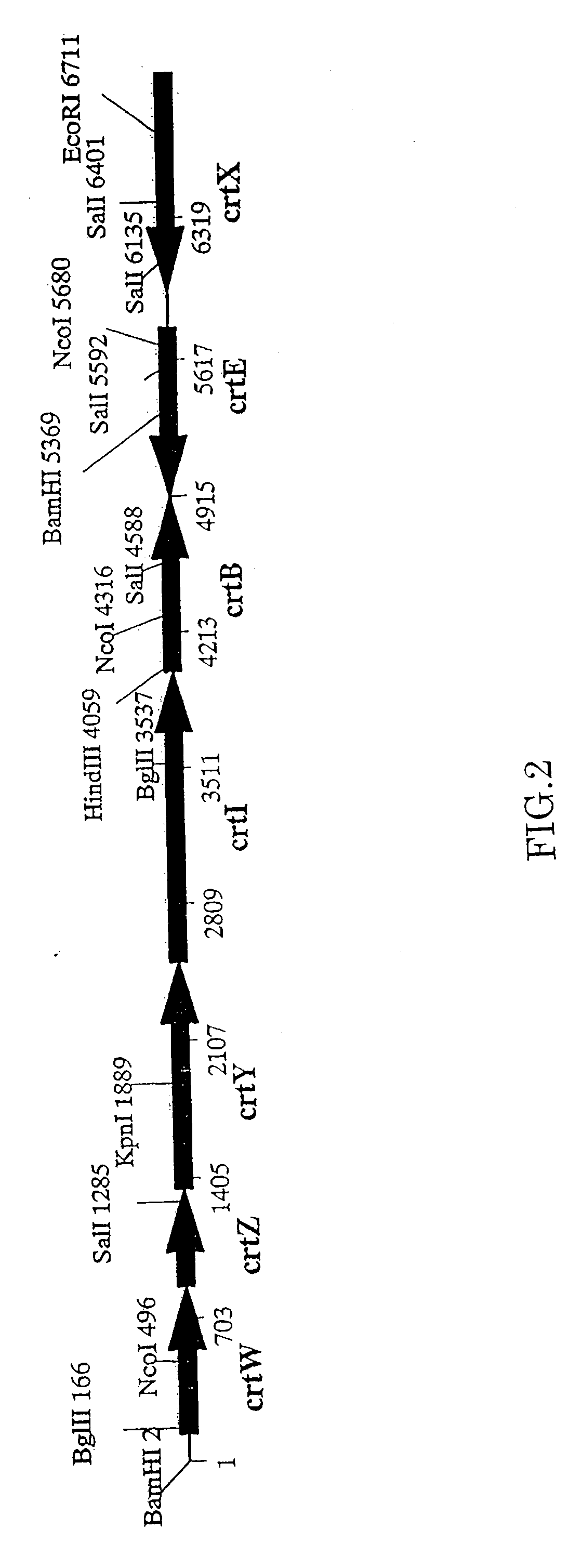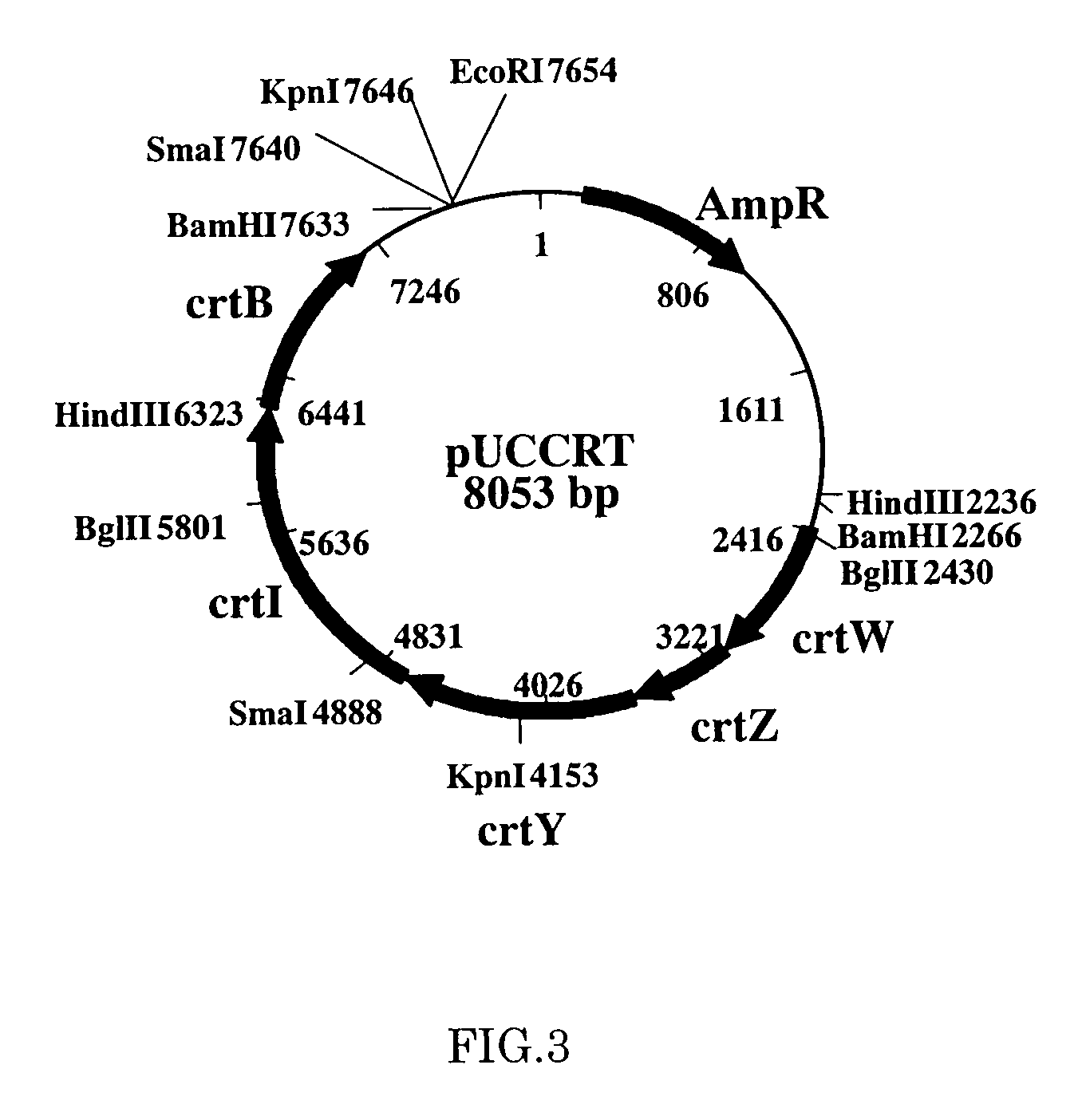Method for production of carotenoid-synthesizing microorganism and method for production of carotenoid
a technology of carotenoids and microorganisms, applied in the field of carotenoidsynthesizing microorganisms and methods for producing carotenoid, can solve the problems of insufficient establishment of effective industrial processes, affecting the production of carotenoid, and affecting the quality of carotenoid, so as to improve the production amount of carotenoid and increase the amount of carotenoid
- Summary
- Abstract
- Description
- Claims
- Application Information
AI Technical Summary
Benefits of technology
Problems solved by technology
Method used
Image
Examples
example 1
Preparation of Genomic DNA Derived from Paracoccus Strain MBIC1143 and Cloning of Carotenoid Synthesis Gene
[0054]Paracoccus sp. strain MBIC1143 was cultured in an OEG culture medium (2 g / L of trypticase peptone, 1 g / L of yeast extract, 8.8 g / L of NaCl; 0.73 g / L magnesium sulfate heptahydrate, 3.6 g / L of anhydrous dipotassium phosphate, 1.4 g / L of potassium phosphate, 1 g / L of D-glucose) at 25° C. (rotary shaking at 120 rpm) for 3 days. Paracoccus sp. strain MBIC1143 was provided by Marin Biotechnology provided by Institute Co., Ltd.
[0055]A genomic DNA was prepared using a kit available from Gentra Systems, Inc. (Puregen Genomic DNA isolation kit) (about 50 ng / ml) Using the prepared DNA as a template, a carotenoid synthesis gene was amplified by PCR. Base sequences of genes (crtW, crtZ, crtY, crtI, crtB, crtE) constituting a group of carotenoid synthesis genes of Paracoccus sp. strain MBIC1143 are described in Non-patent document 2 and Patent document 3. Referring to these published ...
example 2
Preparation of Paracoccus Expression Vector
[0057]Plasmid vector pUCCRT was treated with a restriction enzyme BamHI, and a carotenoid synthesis gene fragment (about 5.4 k base) was obtained. Then the fragment was inserted into BamHI site in a broad-host-range vector pBBR1MCS2. Gene transduction into Escherichia coli strain JM109 was conducted by a heat shock method, and then transformation in a LB agar culture medium containing 50 μg / ml of kanamycin was conducted. An arbitrary transformant having acquired kanamycin resistance was cultured in a LB culture medium (37° C., 18 hours), and plasmid was extracted using a plasmid extraction kit (available from QIAGEN). Treatment of plasmid with a restriction enzyme BamHI demonstrated the presence of the intended insert. There are two orientations for insertion of the insert fragment. To be more specific, a vector in which transcription directions of lac promoter and insert fragment in the pBBR1MCS2 vector are the same (pBBR1MCS2CRT) and a ve...
example 3
Homogeneous Expression of Carotenoid Synthesis Gene in Paracoccus Bacteria
[0058]Each of the vectors pBBR1MCS2CRT and pBBR1MCS2CRTrv into which a carotenoid synthesis gene fragment was cloned was introduced into Escherichia coli strain S17-1 by a heat shock method, and transformation was effected in a LB agar culture medium containing 50 μg / ml of kanamycin and 10 μg / ml of streptomycin. An arbitrary transformant having acquired kanamycin resistance was cultured in a LB culture medium (37° C., 18 hours), and a plasmid was extracted using a plasmid extraction kit (available from QIAGEN) to check whether an objective plasmid was introduced. Then by treatment with a restriction enzyme BamHI, whether the plasmid was properly replicated in Escherichia coli strain S17-1 was checked. The two different plasmid vectors were respectively replicated without occurrence of recombination in Escherichia coli strain S17-1.
[0059]Escherichia coli strain S17-1 having the pBBR1MCS2CRT plasmid vector into ...
PUM
| Property | Measurement | Unit |
|---|---|---|
| Fraction | aaaaa | aaaaa |
| Electrical conductance | aaaaa | aaaaa |
| Density | aaaaa | aaaaa |
Abstract
Description
Claims
Application Information
 Login to View More
Login to View More - R&D
- Intellectual Property
- Life Sciences
- Materials
- Tech Scout
- Unparalleled Data Quality
- Higher Quality Content
- 60% Fewer Hallucinations
Browse by: Latest US Patents, China's latest patents, Technical Efficacy Thesaurus, Application Domain, Technology Topic, Popular Technical Reports.
© 2025 PatSnap. All rights reserved.Legal|Privacy policy|Modern Slavery Act Transparency Statement|Sitemap|About US| Contact US: help@patsnap.com



